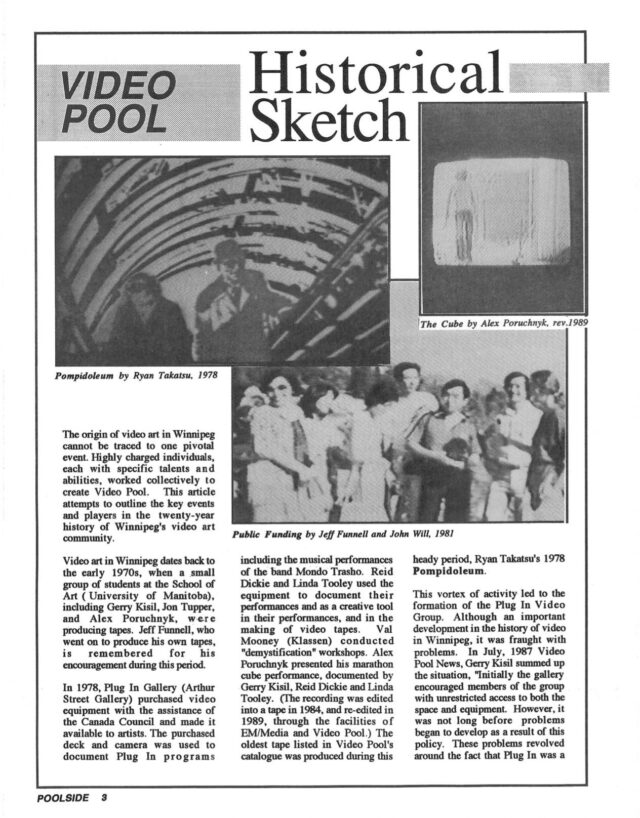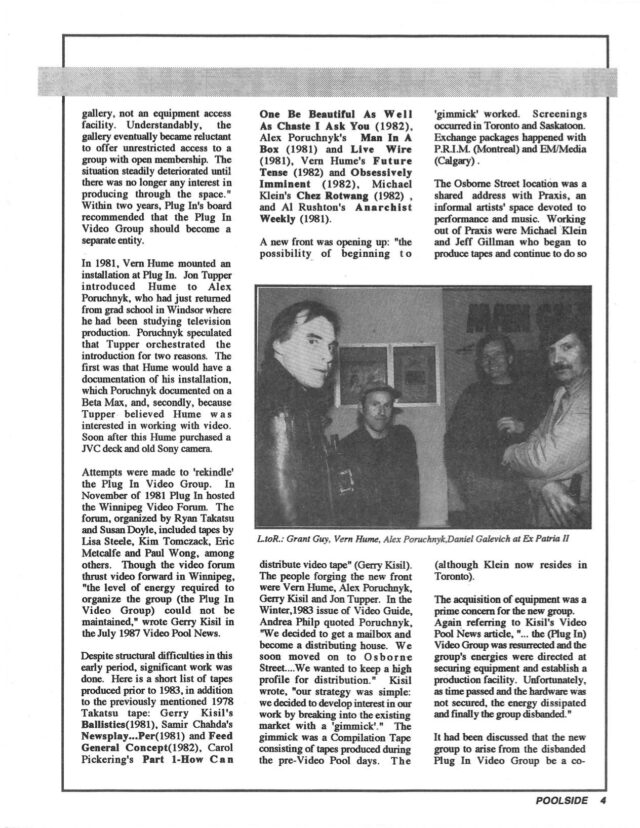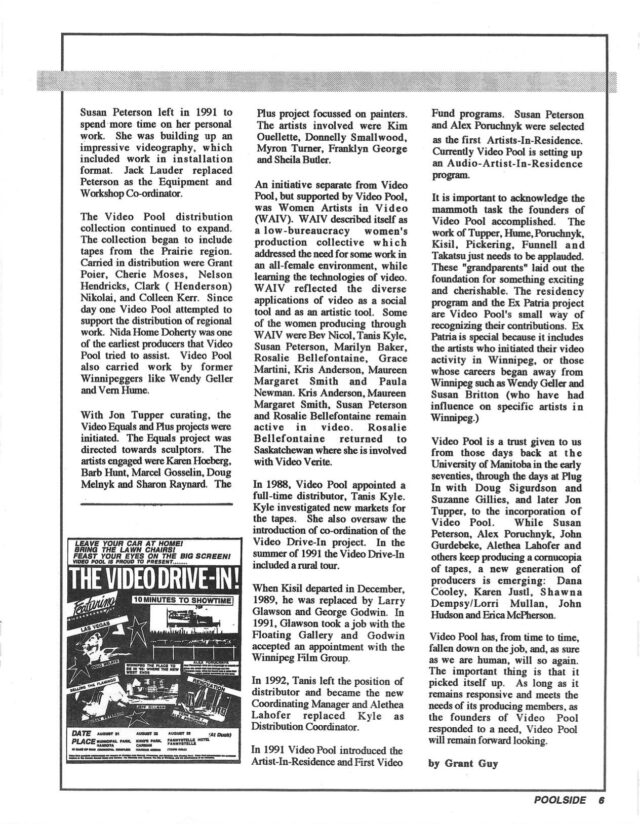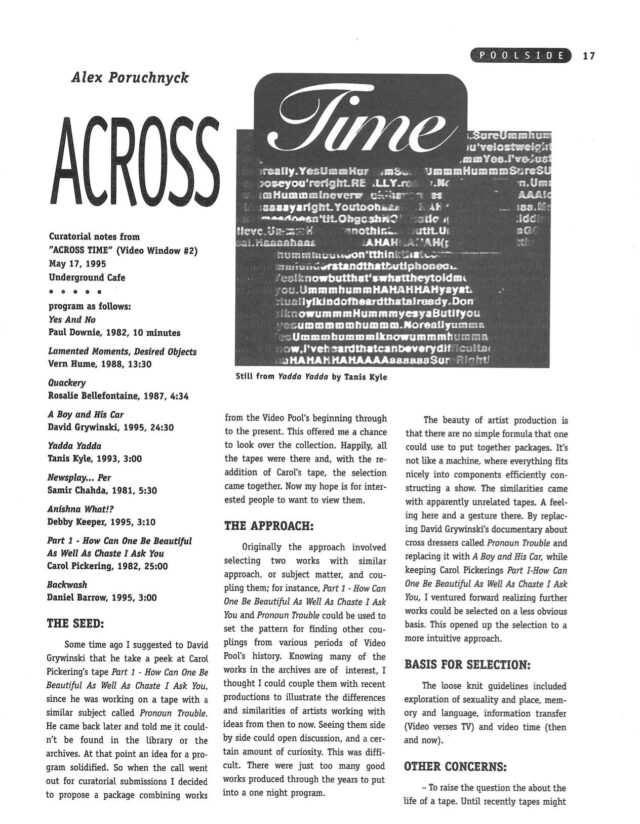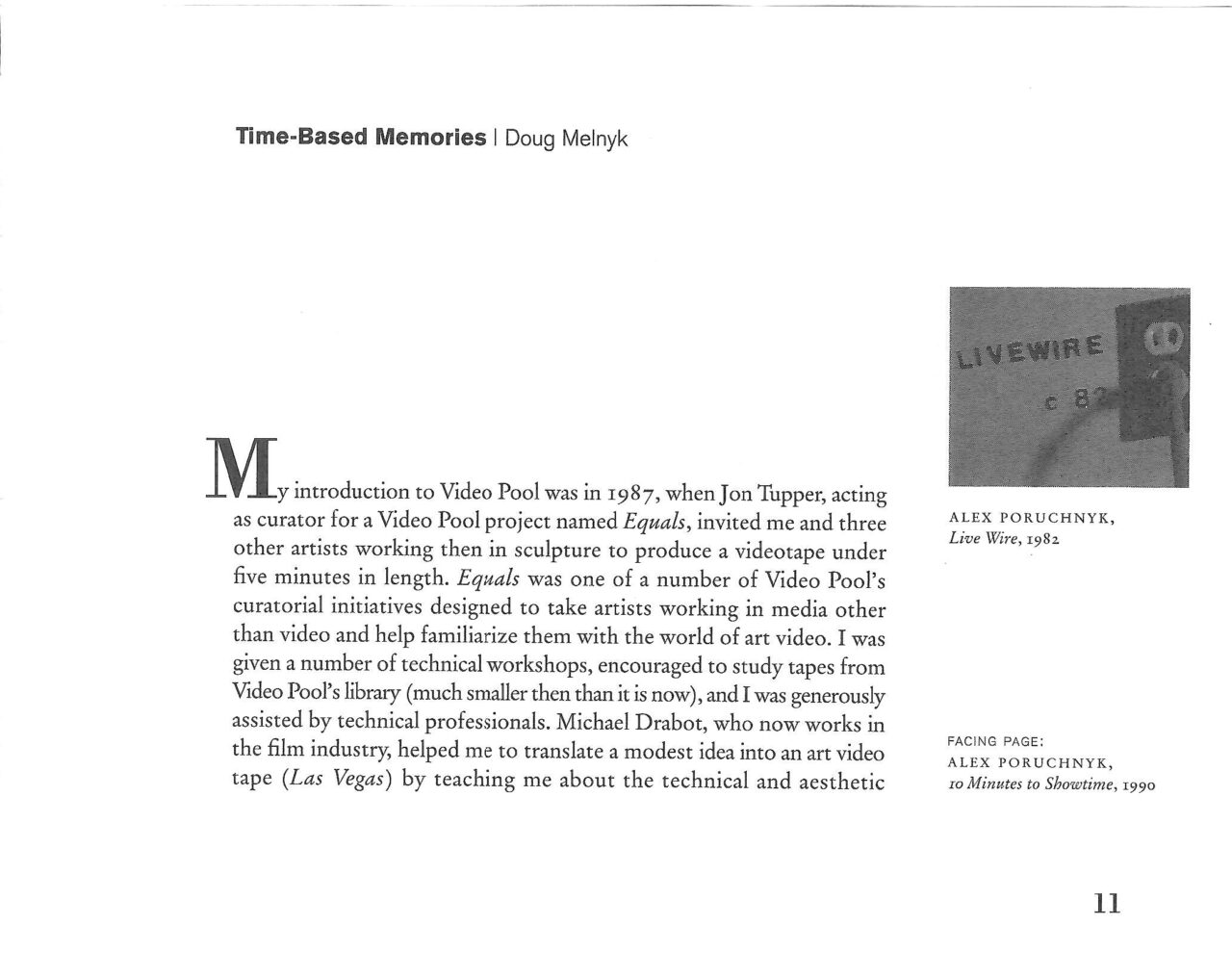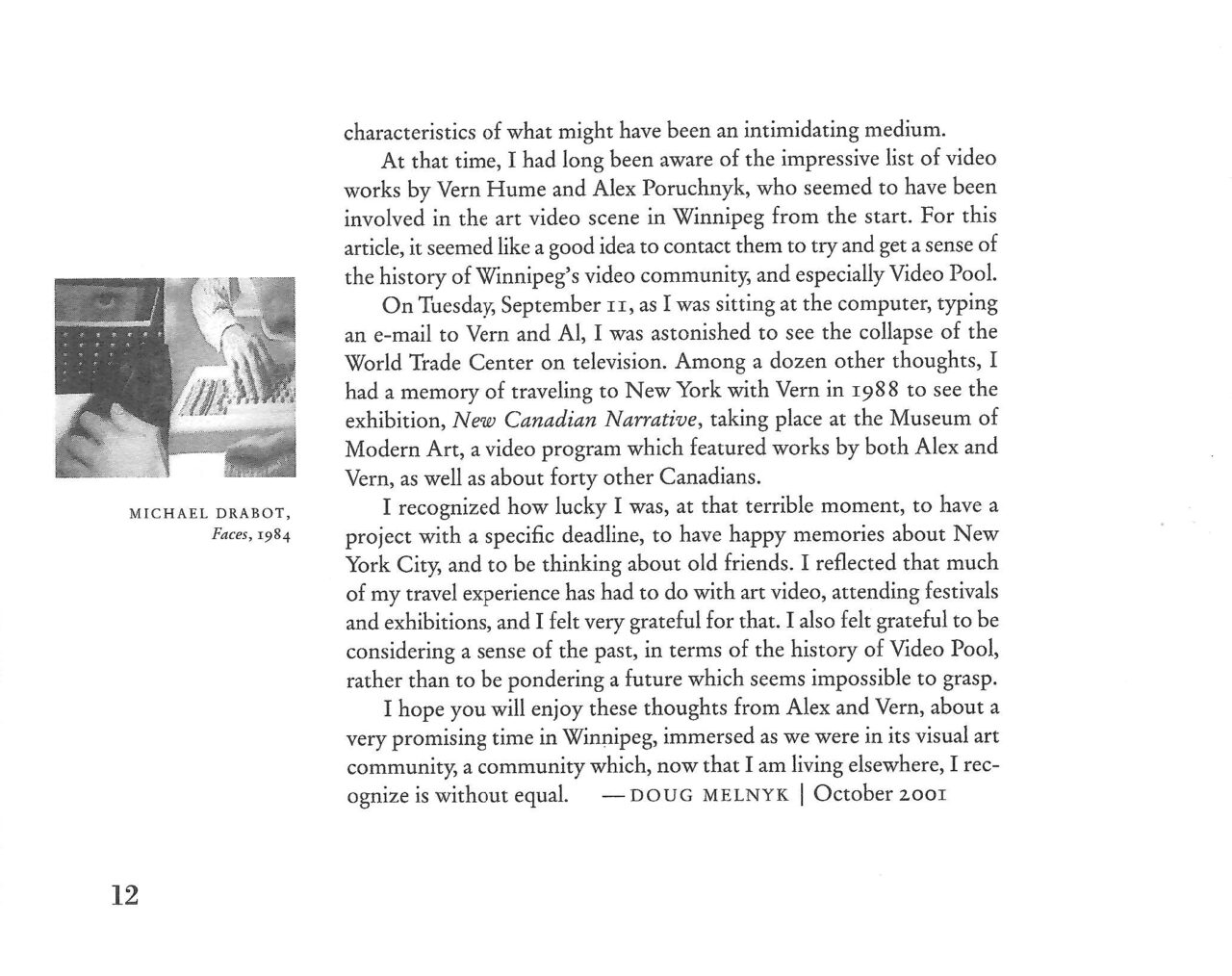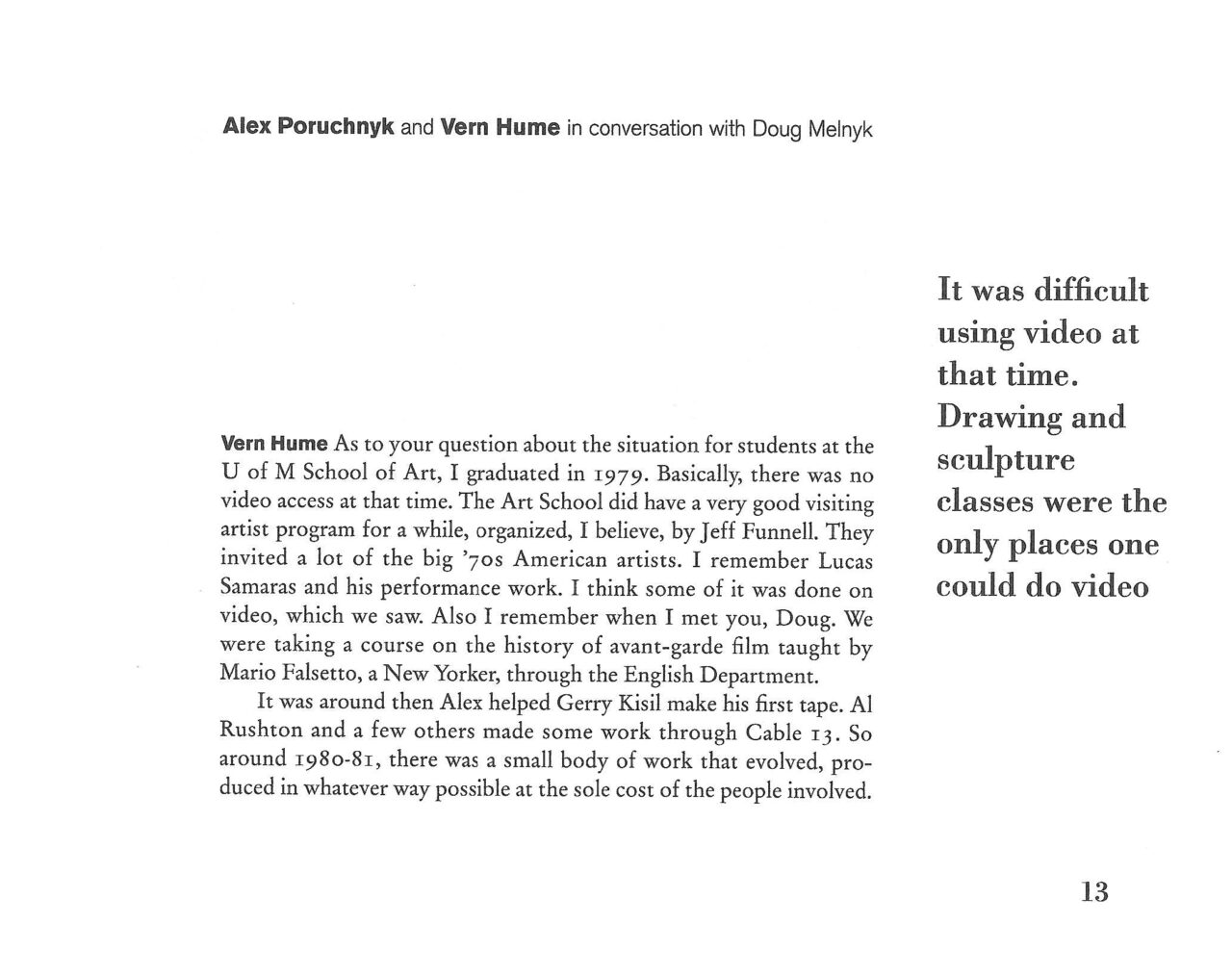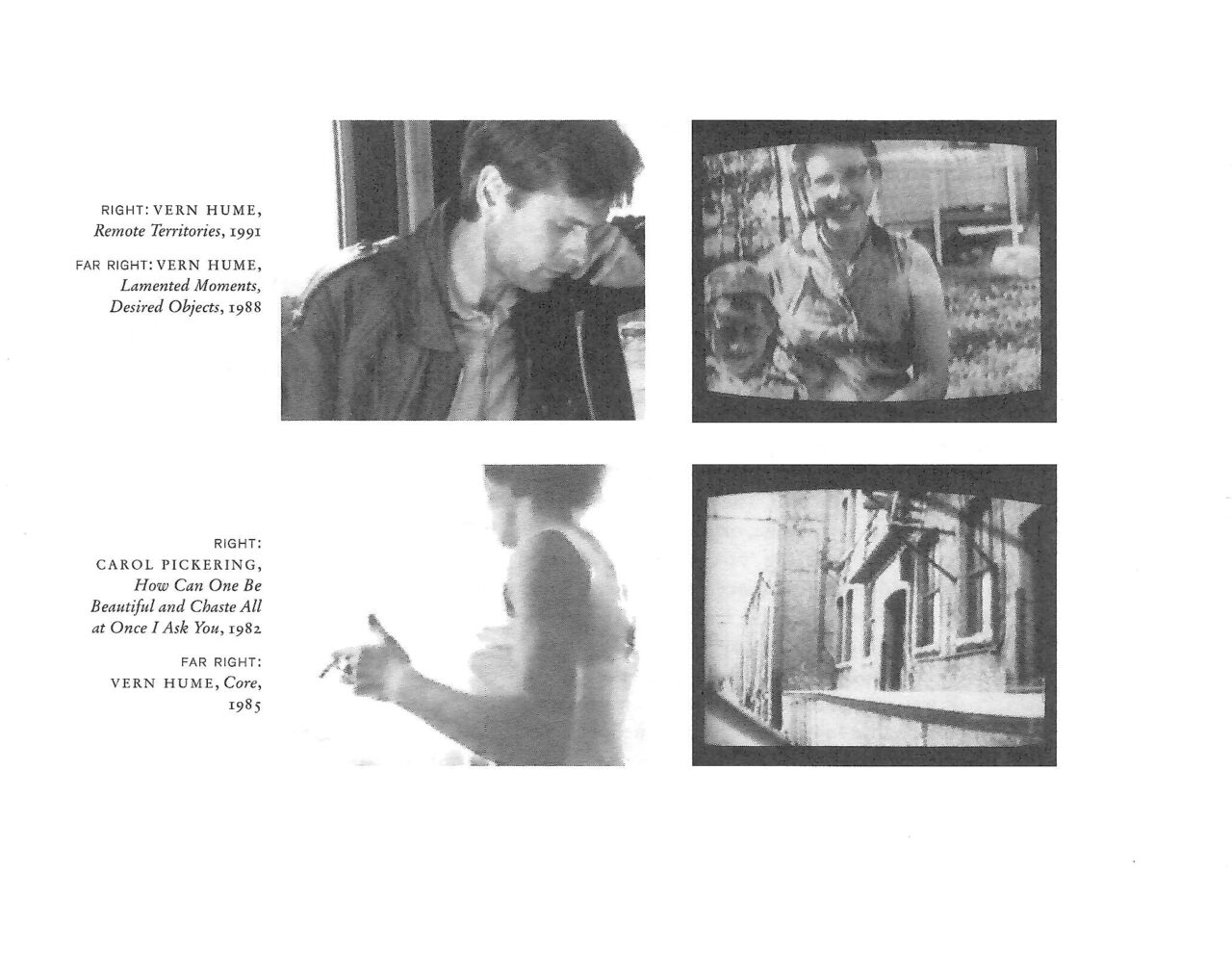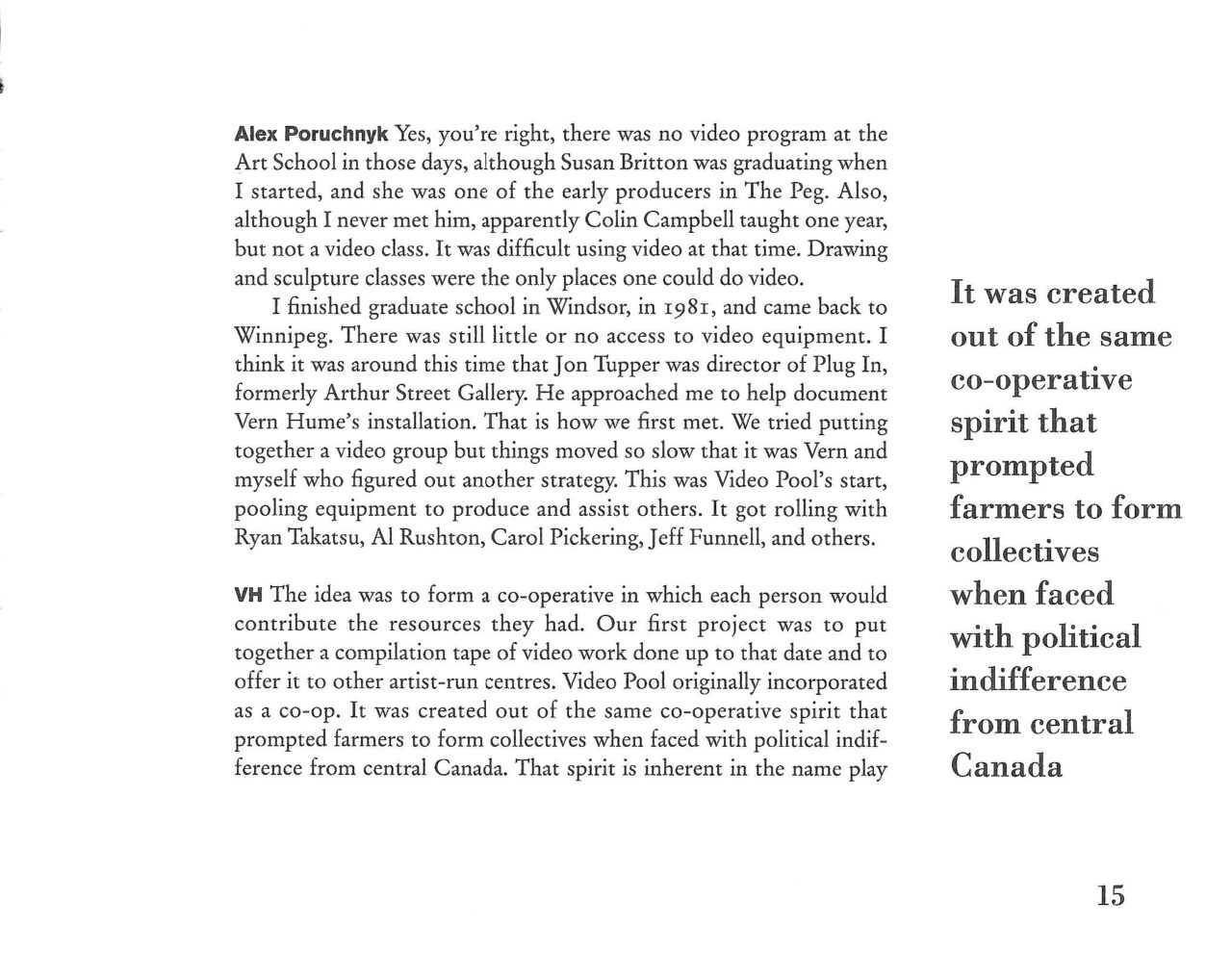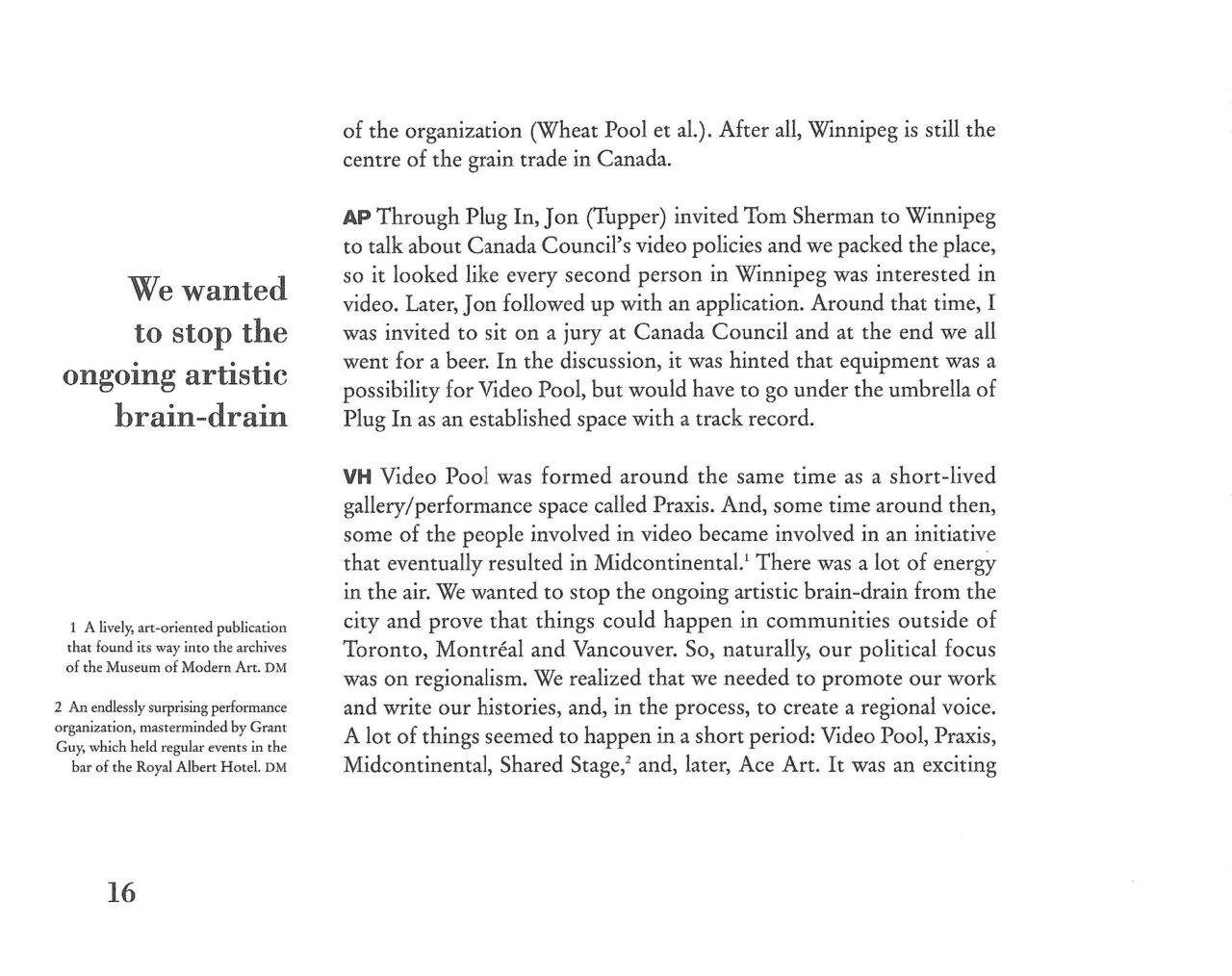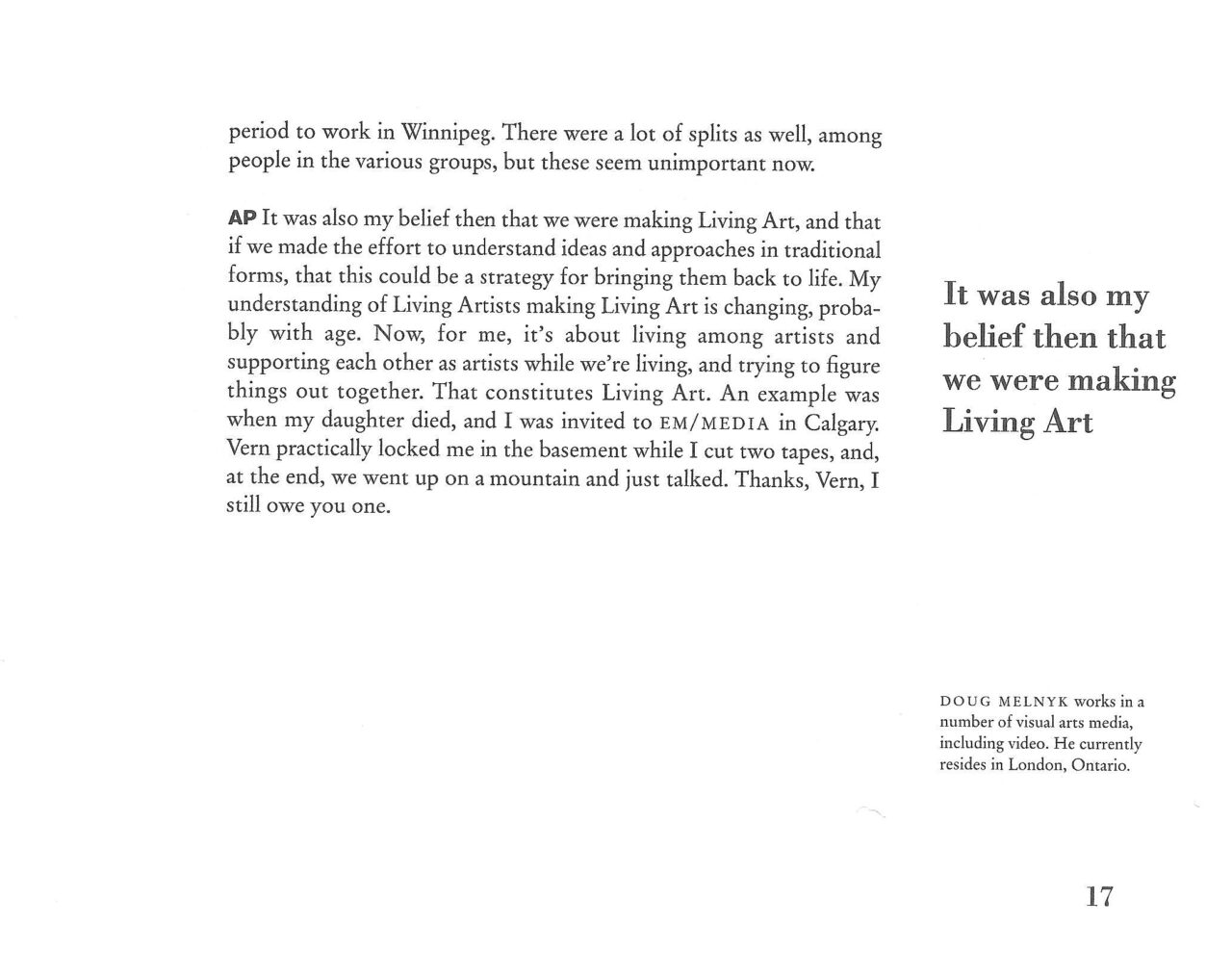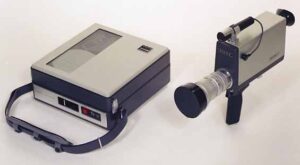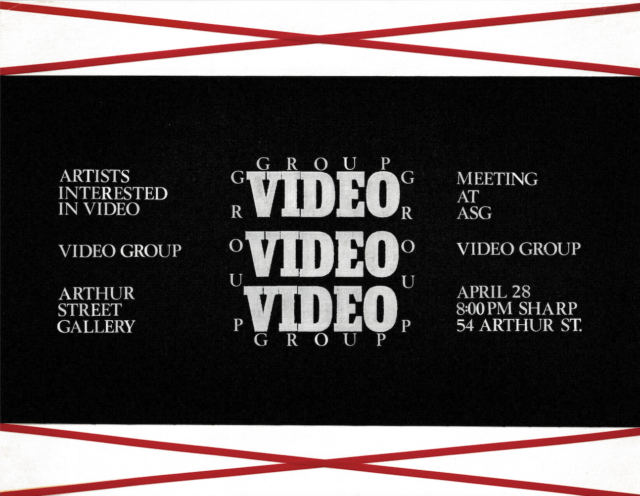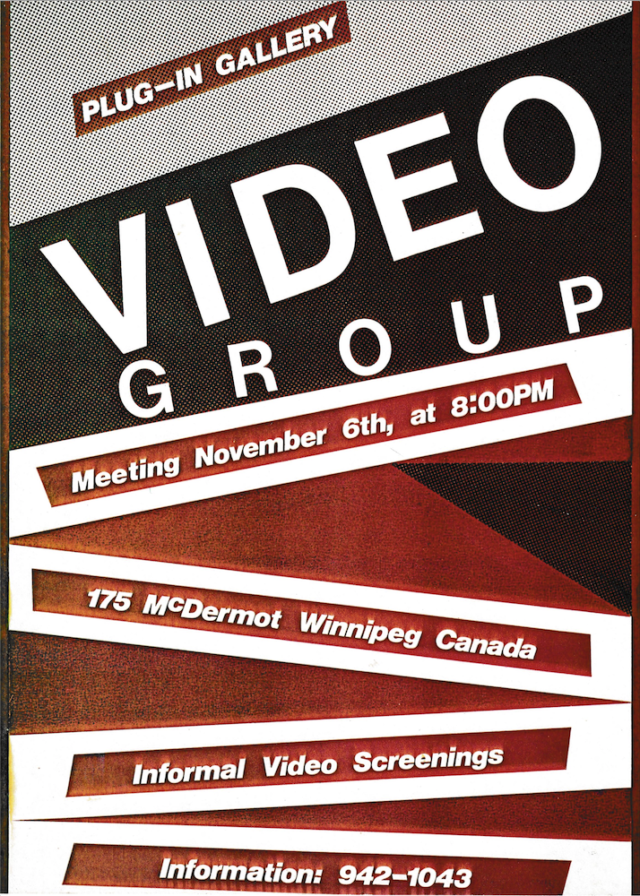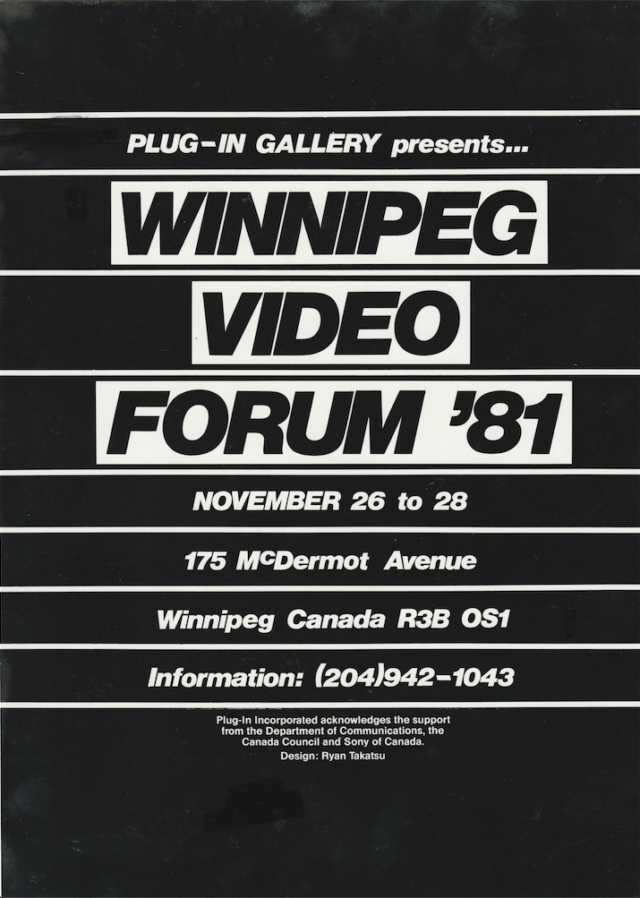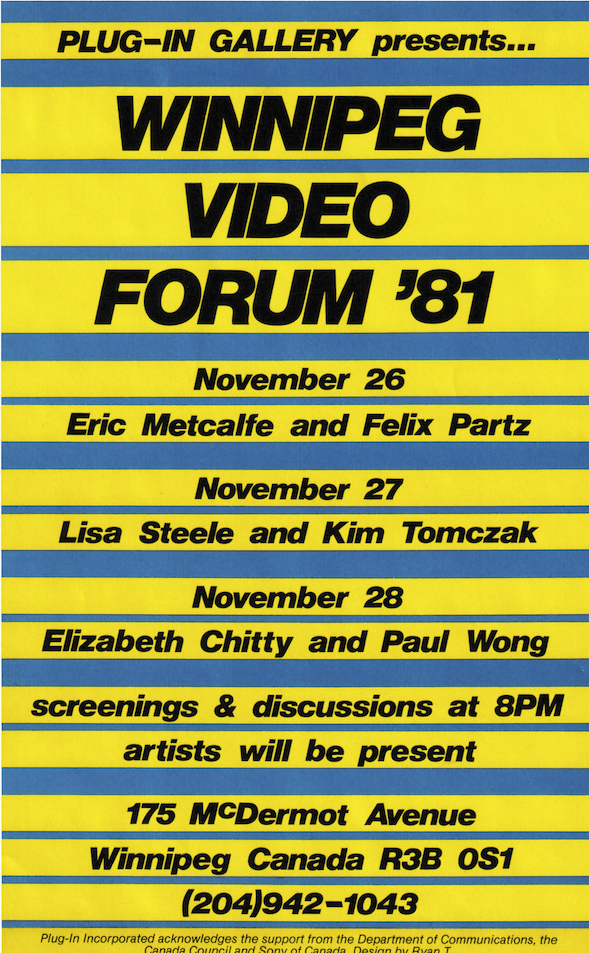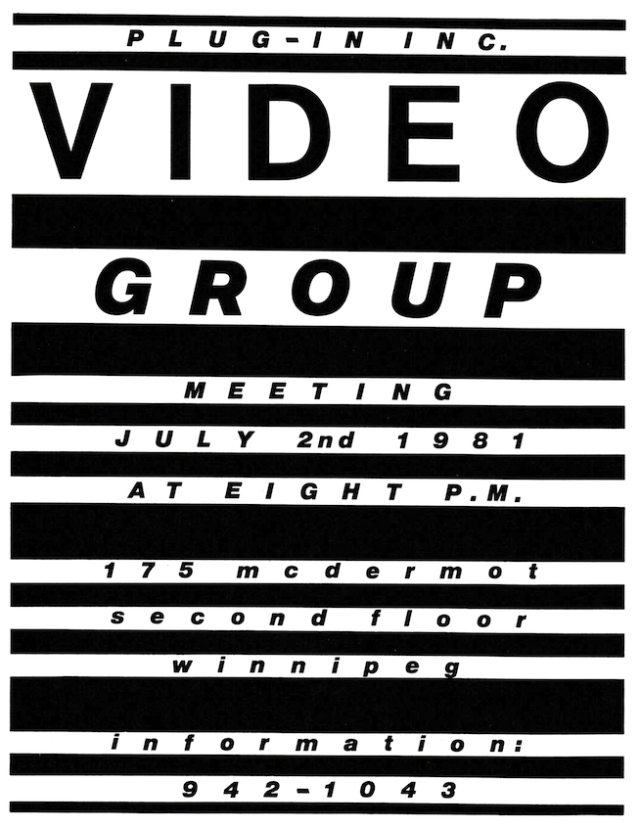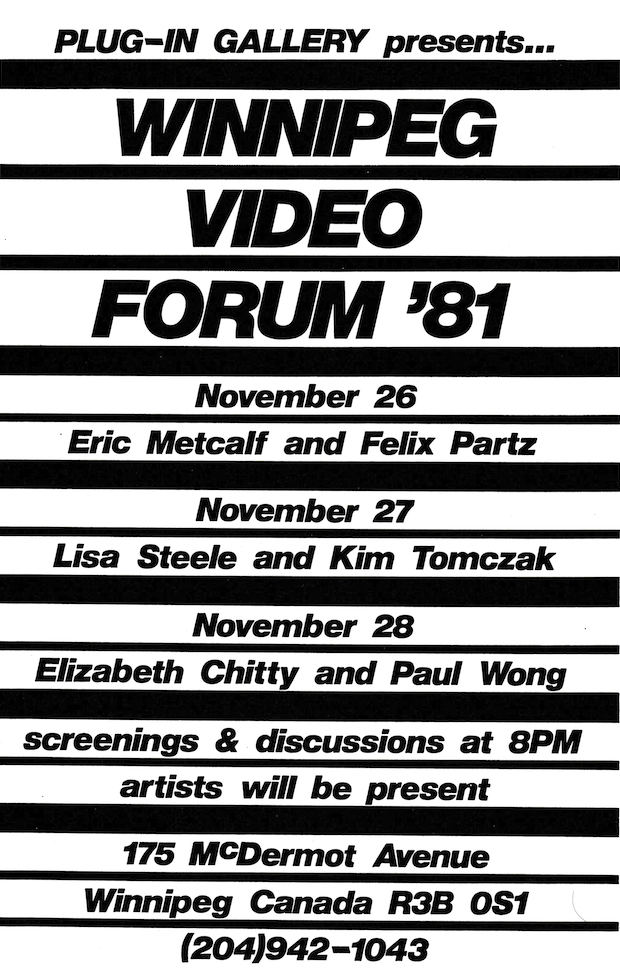VP's Origins + History
The culture that’s going to survive in the future is the culture that you can carry around in your head.
– Nam Jun Paik 1932-2006
A Brief History - Ryan Takatsu (2022)
OVERVIEW
Video Pool Media Arts Centre (VP) developed out of Winnipeg’s Plug In Institute of Contemporary Art and, while still a subsection of Plug In, was known as Video Group. Below is a brief history of VP’s origins as it relates to both Plug In and Video Group.
INTRO
Video Art developed as a new medium opposite to commercial broadcast television when the equipment became more readily available for artists to easily convert sound and images onto magnetic tape. The earliest development of video art came with the introduction of the user friendly and economical Sony Portapak in 1965. The Portapak allowed artists to experiment with capturing and creating content that was narrative, experimental, performative, or conceptual, pushing against creative boundaries and censorship.
Video art made its debut in the 1960s during the Fluxus and Pop Art movements wherein early pioneers challenged and questioned the conventional notions of art through the experimentation and ‘art performances’ that emphasized process over product. Fluxus is often credited with the birth of conceptual art, intermedia, and most importantly in this case, video art.
Korean born-American artist Nam June Paik, is considered to be the first video artist experimenting with and utilizing this new video technology beginning in 1963. Thus began, the exploration of a new art form in a post-industrial society. New York City dominated the production of video art throughout the 1970’s.
From the late 1960’s to early 1970’s, there were four established video centres in Canada located in Toronto, Vancouver, Montreal and Halifax.
In 1969, Halifax, Nova Scotia College of Art and Design (NSCAD) established video facilities for art production, documentation and instructional video which continues to this day. NSCAD’s academic video program was one of the first in Canada that was not an artist-run centre. The college invited international artists to NSCAD to inspire students and artists in the community. In 1979, the Centre for Art Tapes (CFAT) was established under the provincial act as the Society for Art Presentation, focusing on production, programming and disseminaton. Notable early Halifax artists include David Askevold, Ed Slopek and Douglas Waterman.
In 1970, Toronto, A Space was first to introduce video production workshops to a new generation of media artists. As a result, Trinity Square Video, Charles Street Video, Vtape and Art Metropole were established to serve the community-at-large through production, distribution and an information resource, respectively. Toronto emerged as an important centre for video art. Due to its close proximity to New York City, video had an influence on Toronto art culture. Toronto artists began producing work dealing with social-political issues and challenging censorship by Lisa Steele, Colin Campbell, Vera Frenkel, Susan Britton and General Idea.
In 1969, Vancouver’s Intermedia began recording events and performances on video. In 1973, members of Intermedia put together the Matrix International Video Conference, the first known international conference of its kind and it included tapes from the USA, Canada, Japan and Europe. The conference inspired and ultimately created the Satellite Video Exchange Society (Video Inn), Vancouver’s first video production and distribution centre. In 1976, the Western Front also started supporting video productions by national and international artists. These organizations have achieved an international reputation in video art. At the time, video art in Vancouver focused on social and political issues including identity, racism, and feminism, with notable works by Paul Wong, Sara Diamond, Byron Black and Kate Craig.
In 1971, Montreal, the National Film Board (NFB) created the first independent video centre for experimental filmmakers, Le Vidéographe. In 1972, Vehicle Art gallery began video production, recording and programming and in July 1981, spun-off its video section to become Productions et Réalisations Indépendantes de Montréal (PRIM). Coop Vidéo de Montréal was founded in 1976 and followed the method of direct cinema. Le Vidéographe produced videos dealing with social activism through a technique called direct cinema developed by Pierre Falardeau and Giles Goulx at the NFB which had an influence on video artists in Québec, such as Frank Vitale, Robert Morin and Lorraine Dufour.
The support of the Canada Council continued and later provincial-civic governments, private and public organizations have allowed these pioneering media art centres to create and to establish a national and global watermark in video art.
VIDEO GROUP – ORIGINS
Living on the prairies of big blue sky and an endless horizon, early 1970s video art production in Winnipeg was non-existent. At the time, Plug-in had no in-house video production equipment and there was no outside access to equipment. Winnipeg being far away from major video centres like Toronto, Vancouver, Montreal and Halifax meant there was no option to produce any tapes and the only pre-internet inspiration was viewing tapes through Plug-In, University of Manitoba School of Art and Winnipeg Art Gallery.
In 1976, for those who watched late night television through their local cable company, there arose a rare opportunity to view some of these early works, a first for a mainstream television broadcast, featuring mostly American video artists.
Locally, there were only three emerging video artists in Winnipeg.
Plug-In was not an option. No Tech. No Art.
Reid Dickie and Linda Tooley (aka DickTool Co) are considered to be among the earliest Winnipeg-based video artists. Reid was born in Brandon and Linda was born in Winnipeg. He was educated at Ryerson Polytechnical Institute (now Ryerson University), Toronto majoring in Radio and Television Arts. After graduation, he worked for a number of radio stations throughout Manitoba. With a Sony Portapak on loan from Manitoba Tourism and full access to the facilities at Videon Cablesystems VPW (665 Strafford Street) they became Winnipeg’s most prolific video artist teams. In 1978, they produced a bi-monthly 30-minute cablecast, called Videosphere at VPW. Notable works emerging from these cablecasts include: No Shirt No Shoes No Service (1978) and Mechanical Bliss (1978). Reid Dickie was Plug-In’s first video coordinator and interim chair of the Video Group 1979-1980. Their vast catalogue of over 40 videos were never submitted to Video Pool and/or other artist-run centres for media distribution. Most of their videos are now available for viewing on YouTube. Both Reid Dickie and Linda Tooley passed away in 2016 and 2009 respectively.
Ryan Takatsu was the missing link in Winnipeg’s video art history and is credited with producing the first known work of video art out of Winnipeg. While studying at the University of Manitoba’s Faculty of Architecture, Interior Design, he volunteered at Greater Winnipeg Cablevision (located at 930 Nairn Avenue), where he acquired experience in local public television production. After viewing a late night American talk show showcasing video artists, he was inspired to produce two experimental tapes: Summerwork 76 (1976) and Pompidoleum (1978) for a design presentation class. The tapes were never screened due to the lack of video equipment in the university’s A/V department. Incidentally, Pompidoleum received little recognition nor was it included in any curated video art shows. Ryan Takatsu is one of the founding members of the Video Group which eventually became Video Pool Media Arts Centre. Pompidoleum was Video Pool’s first acquisition to its distribution catalogue. Most recently, the recovered archival work, Summerwork 76 was added to VP’s catalogue.
PLUG-IN MANDATE:
HARDWARE ACCESS and TO CREATE AND PRODUCE CONTENT.
A BRIEF CHRONOLOGICAL HISTORY OF VIDEO THROUGH PLUG-IN
1972
November 1972
Plug-In was founded as an artist-run centre in 1972 by Doug Sigurdson, Suzanne Gilles and Lorraine Raboud. Now called Plug In Institute of Contemporary Art (ICA), it has gained national and international acclaim for its contemporary art programming and activities that continue to this day.
1975
March 26 1975
Quebéc Vidéo co-sponsored by Gallery 111, School of Art, University of Manitoba
1976
October 6 1976
Glamour by General Idea – A.A. Bronson, Felix Partz and Jorge Zontal
Video Screening: Going Through the Motions by General Idea
May 1976
SCAN: Survey of Canadian Art Now by various Canadian artists; toured by Vancouver Art Gallery
1977
September 7 1977
Canada Council Request for funding $39,682.00; Declined.
Canada Council, Video Programme available for video groups and artists: Aid to Artists, Explorations and Video Programme
September 16 1977
Canada Council, Video Office application to create a video department at Arthur Street Gallery. Reid Dickie was Plug-In’s first video coordinator and interim chair of the Video Group 1979-1980.
1978
January 5 1978
Canada Council, Visual Arts Film and Video approved $6,300 grant for video programming at Arthur Street Gallery.
January 5 1978
Canada Council, Video Programme was unable to fund new production facilities due to limited funding. Plug-In received a small Canada Council grant for the purchase of video equipment; Sony VO2600, Sony Trinitron KV2101 and Sony 3600DX camera plus tripod, dolly, microphone and lighting. Plug-In Mandate: to provide access to video production equipment to artists; non-commercial purposes; Video Coordinators: Val Mooney and Alex Poruchnyk; Membership only.
February 1978
Or So it Seems – Video Installation by Gordon Lebredt
March 29 1978
Interference – Video by Susan Britton
August 5 1978
An Invitation to All Local Video Artists.
Open screening: Format 1/2″ open reel and 3/4″ Umatic
August 16 to Sept 2 1978
No Shoes No Shirt No Service – Video by Reid Dickie and Linda Tooley
October 17 1978
Plug-In Video Access Policy is developed
November 25 1978
Mondo Trasho Live Performance at Plug-In
December 15 1978
Mondo Trasho Tapes – Videon VPW-TV 3-hour programme
1979
Date unknown 1979
Reid Dickie becomes Plug-In’s first video coordinator and interim chair of the Video Group 1979-1980.
January 3-11 1979
If you find this tape… Destroy the Tower – Video by Susan Britton
January 20 1979
Video Coop was established in 1979 with a membership of 35 people.
General Membership $5.00; Students $3.50
February 1 1979
Plug-In Artists Video Group
Basic video production equipment available for artists access at Arthur Street Gallery.
Equipment inventory: Sony VO2600 VTR, Sony Trinitron KV1920D and Sony AVC3260DX
March 8 1979
Arthur Street Gallery Committee meets to elect first Video Access chairperson.
March 6-30 1979
Modern Love – Video by Colin Campbell
March 9 to April 12 1979
In Video
First major Winnipeg exhibition of video art featuring work from Canada and USA. Organized by Peggy Gale, director of film and video at Art Metropole. Featuring 23 artists. Location: Winnipeg Art Gallery
May 8 1979
Video Group: due to lack of funding, no coordinator was hired for 1980-81
May 26 1979
Application to the Canada Council, Video Section
May 1979
Action 58 – Video by Herman Nitsch
News From Europe – Video by Fabio Mauri
June 13 1979
Arthur Street Gallery receives $2,200 for equipment purchase from the Canada Council for the Arts, Video Section.
August 11 1979
The Casting Call & Message to China – Video by Susan Britton
October 20 1979
Application to the Canada Council for the Arts, Visual Arts Section for Core Operational funding for video production. Amount requested $25,645. Video production begins at Arthur Street Gallery in the last months of 1978-79 and continue throughout the year. Umatic VTR colour is purchased for screening artists tapes followed by B/W video camera for video production. Plans for 1978-80 consist of continuation and expansion of the Artist Access to Equipment membership program. [1]
Key Players at the Canada Council for the Arts: Edith Goodrich, Renee Baert and Tom Sherman
Plug-in Artists Video Group Launch
Artist Access to video equipment through membership.
Membership at the time: 15 Winnipeg artists, expecting an increase of 10.
December 15 1979
Bad Girls – Video by Colin Campbell
1980
January 1980
Video Group members list included Dan Wassail, Walter Lewyc and Pierre Champagne.
April 28 1980
Video Group meeting
Artists interested in video; Arthur Street Gallery, 54 Arthur Street, Winnipeg; Time 8:00 PM
September 1980
Mechanical Bliss – Video by the DickTool Company (Reid Dickie and Linda Tooley)
October 24-25 1980
Video tapes from V/Tapes
Da Da a Go Go by Susan Britton, Colin Campbell, Clive Robertson, Lisa Steele and Rodney Werden
Date unknown 1980
Reid Dickie, chair of Video Group was terminated by the board of directors. Funding diverted to programming.
Doug Sigurdson and Suzanne Gilles depart from Arthur Street Gallery and Jon Tupper is hired as Plug-In Inc. Managing Director.
1981
March 1981
Video Policy Proposal submitted to Board of Directors: Alternative Video Strategy for Plug-In
March 21 1981
Tom Sherman visits Plug-In with a loan from the Canada Council for the Arts, Video Section video equipment. At this time there was no long term commitment from the Canada Council. Emerging video artists were invited to write to the Canada Council for a free case of 3/4″ Umatic videotapes.
May 26 1982
Plug-In programming artists’ videotapes since 1975.
Plug-In receives a grant for the Canada Council to purchase a Sony 3/4″ Umatic VTR, Sony B/W video camera and accessories.
July 2 1981
Video Group meeting
Plug-In Inc. 175 McDermot Avenue, Winnipeg Manitoba; Time: 8:00 PM
From memory: Ryan Takatsu, Jeff Funnel; Al Rushton; Gerry Kisil, Vern Hume and Alex Poruchnyk; Honourable mention: Samir Chada and Carol Pickering who produced videos during the very early 1980s; No minutes.
August 18 1981
Video by Artists: Al Rushton and Randy and Berinicci
March 1981
An application is made to the Federal Department of Communications Special Program of Cultural Initiatives (Keith Kelly) by managing director, Jon Tupper, with support from the board, to fund the Winnipeg Video Forum ’81. Application details:
– To host an exhibition of major works by Canadian video artists.
– To provide an national perspective on issues related to video for Winnipeg artists
– To allow for the exchange of video art on a nation-wide scale
Winnipeg Video Forum ’81 was a first of its kind forum in Winnipeg. It provided the University of Manitoba, School of Art students some exposure to the latest video art productions, to meet the artists and to network with a cross-section of international video artists. Activities included:
– Seminar on the distribution of art tapes
– Cablecast of art tapes on public access television
– Telidon New Directions: pre-internet technology utilizing videotex/teletext service developed by the Canadian Communications Research Centre (CRC) which was first deployed for public testing in Manitoba (not included in the forum).
The University of Manitoba’s Department of Communications provided funding of $5,000 towards this ground-breaking Winnipeg Video Forum ’81. [1]
November 6 1982
Video Group meeting
Plug-In Inc. 175 McDermot Avenue, Winnipeg Manitoba; Time: 8:00 PM
From memory: Ryan Takatsu, Jeff Funnel; Al Rushton; Gerry Kisil, Vern Hume and Alex Poruchnyk; No minutes found.
November 26-28 1981
Winnipeg Video Forum 81
– Paul Wong, Vancouver
– Eric Metcalfe, Vancouver
– Ron Gabe (aka Felix Partz of General Idea), Toronto
– Lisa Steele, Toronto
– Kim Tomczak, Toronto
– Elizabeth Chitty, Toronto
The forum invited video artists from across Canada whose work had been recognized nationally and internationally. Premiered the current state of video art produced in Canada to a Winnipeg audience.
The forum was successful in many ways, and attracted an estimated 300 attendees to the three-day event including evening screenings and an after party to network with the artists about distribution and production. In addition, The DickTool All-Night TV Show cablecasted (east and west of the Red River) on November 27 from 11:30 pm to 5:00 am featuring video by local artists and alternative music videos.
Forum coordinators: Susan Doyle (Minneapolis, MN, studying architecture at the University of Manitoba) and Ryan Takatsu
December 1981
Post Nuclear Video – Video by Reid Dickie
1982
March 19 1982
Video by Ko Nakajima (Japan)
September 22 1982
Canada Council for the Arts, Visual Arts – Film and Video grant approved for Plug-In in the amount of $26,639 for video equipment purchases.
Mandate: To establish a video facility for Winnipeg artists. Canada Council stated in a letter to Plug-In that it reserves the right to designate an alternative owner should the recipient organization dissolve or cease to carry out the activities for which hardware is provided.
Video at Plug-In Inc.
Video as an art form has transformed into an important medium of expression for artists of the 20th century. At the time, Winnipeg had fallen behind the rest of the country in developing a centre for video production. Video programming at the Winnipeg Art Gallery and Plug-in had started showcasing both Canadian and international videos.
Alternative Video Strategy for Plug-In Inc.
Video Group was in the process of organizing reform that would be beneficial to the group and gallery. This reform was critical to seeking core funding for equipment purchase and maintaining access to members. According to the Canada Council records, they spent $428,200.00 per year for equipment and operations of 18 video groups and 5 video production artist-run centres across Canada. The Video Group would be eligible for funding within that grant criteria. The concept was that Plug-In would be the umbrella organization of the Video Group until Video Group was able to establish non-profit status and a board of directors. The Video Group would temporarily use the gallery space and equipment under a mutual agreement.
This type of passive support proved to be of great assistance during the Video Group’s formative period. Once its own sources of funding became available Video Group would become independent from the gallery. As there were some areas of common interest between the gallery and Video Group, it was to the gallery’s advantage to develop Video Group into an independent artist-run centre in Winnipeg. [1]
May 26 1982
Plug-In has been programming video art since 1975.
Established in 1979, Video Group has an active membership of 35 individuals. For parallel artist-run centres across Canada, video programming had a major impact in visual arts. There is a growing audience and interest in the medium as an art form.
Artists accessing video production facilities in Winnipeg is limited or non-existent. Local cable companies, National Film Board, the Provincial Government and Universities were not an option. Only a select few artists were able to access local cable companies with broadcast quality studios for video art. [1]
1983
January 28 1983
Ryan Takatsu resigns from the Plug-In board of directors to become co-founder and publisher of Midcontinental: Charm, Good Thinking News and Culture and continues to freelance as a graphic designer.
January 28 1983
Alex Poruchnyk resigns from Plug-In board of directors.
March 1983
Video Screening: PRIM Montreal Video Exchange
May 3-14 1983
1984 Ottawa International Festival of Video Art; Organized by SAW Gallery, Ottawa
November 1983
Confused: Sexual Views – Video by Paul Wong
New Video – Video by Randall and Bendinelli
January 19, 1983
Video Pool Inc. is established.
Gerry Kisil becomes the first coordinator of Video Pool.
Office/Studio was located at 87 Princess Street, Second Floor, Winnipeg, Manitoba.
FOUNDING MEMBERS
Ryan Takatsu
Grant Guy
Alex Poruchnyk
Vern Hume
Gerry Kisil
John Tupper
[1] Reference and credit from the Plug In ICA files at the Archives of Manitoba. Compiled and sorted for this article.
REFERENCES
Archives of Manitoba
Plug-In ICA Art Research Centre
Web
https://plugin.org
http://www.videopool.org
https://canadianart.ca/features/why-the-nscad-legend-mattered-and-still-matters/
https://www.thecanadianencyclopedia.ca/en/article/video-art
https://canadianart.ca/interviews/life-in-video
https://en.wikipedia.org/wiki/Video art
https://books.google.ca/books?id=QQq5AQAAQBAJ&printsec=frontcover&source=gbs_ge_summary_r&cad=0#v=onepage&q&f=false A History of Video Art
https://interaccess.org/event/2020/barbara-london-and-lisa-steele-conversation-videoart-and-its-evolution
https://www.trebuchet-magazine.com/video-art-the-first-fifty-years/?fbclid=IwAR1dwpAtECiE7j38kkyO1zS_ZGCMir7CBSmpQlNg7yezbXtu-NN5bkJfEQE Video/Art: The First Fifty Years
https://www.youtube.com/watch?v=qCy5e1MSJAs Back In The Day 1972-2002 Plug-In Retrospective; Interview with Reid Dickie and Linda Tooley
https://readreidread.wordpress.com/dicktoolco-art-actions-3/ Reid Dickie and Linda Tooley
http://www.videopool.org/catalogue/artists/?id=337 Ryan Takatsu
http://japanesecanadianartists.com/artist/ryan-takatsu/ Ryan Takatsu
http://www.vtape.org/artist?ai=1164 Susan Britton http://www.vtape.org/artist?ai=34 Kate Craig
http://www.vtape.org/artist?ai=43 Colin Campbell
http://www.vtape.org/artist?ai=57 Kim Tomczak
http://www.vtape.org/artist?ai=109 Elizabeth Chitty
http://www.vtape.org/artist?ai=113 Vera Frenkel
http://www.vtape.org/artist?ai=148 Paul Wong
http://www.vtape.org/artist?ai=284 Douglas Waterman
http://www.vtape.org/artist?ai=872 Lisa Steele
https://en.wikipedia.org/wiki/David_Askevold
https://vucavu.com/en/artists/b/byron-black
https://en.wikipedia.org/wiki/Colin_Campbell_(artist)
https://en.wikipedia.org/wiki/Elizabeth_Chitty
https://en.wikipedia.org/wiki/Kate_Craig
https://en.wikipedia.org/wiki/Sara_Diamond_(college_president)
https://fr.wikipedia.org/wiki/Lorraine_Dufour
https://en.wikipedia.org/wiki/Pierre_Falardeau
https://en.wikipedia.org/wiki/Vera_Frenkel
https://en.wikipedia.org/wiki/General_Idea
https://en.wikipedia.org/wiki/Gilles_Groulx
https://en.wikipedia.org/wiki/Eric_Metcalfe
https://en.wikipedia.org/wiki/Robert_Morin
https://en.wikipedia.org/wiki/Nam_June_Paik
https://en.wikipedia.org/wiki/Felix_Partz
https://findingaids.library.dal.ca/slopek-edward
https://en.wikipedia.org/wiki/Lisa_Steele
https://en.wikipedia.org/wiki/Paul_Wong_(artist)
Book
Gale, Peggy, editor. Video by Artists. Toronto, CANADA: Art Metropole, 1976. Print.
Meigh-Andrews, Chris. Second Edition A History of Video Art. New York USA; Bloomsbury Academic, 2014. Print/PDF
Catalogue
Canadian Video Art. Réne Coëlho, Aart van Barneveld, Karen Henry and Elke Towne. Netherland Video Circuit, Amsterdam, HOLLAND: 1985. Print.
In Video. Peggy Gale. Dalhousie Art Gallery. Halifax CANADA: 1977. Print.
Retrospective 4: 1979-80 Document of Artist-run Centres in Canada. Toronto CANADA: ANNPAC 1980. Print.
Spaces by Artists / Places des artistes / 3e Rétrospective Parallèogramme 3 1978-79. Toronto CANADA: ANNPAC 1979. Print.
Timeline for Plug In ICA’s 40th Anniversary Catalogue 1972-2012. Winnipeg CANADA: Plug-In ICA 2012. PDF.
Video Pool Inc. Distribution Catalogue. Edited by Kris Anderson and Ryan Takatsu. Winnipeg CANADA: Video Pool Inc. 1987. Print.
Magazine
Robin Arn, Fuji Nakaya, Carol Zemel et al. “The Issue of Video Art”. Artscanada, October 1973. Toronto CANADA. Print.
Graphic design of Plug In posters: Ryan Takatsu
Thank you to Erin, Jenifer, Jen and Emma.
Ryan Takatsu is a sansei, designer, video artist and cultural equity advocate. Born in Winnipeg and studied at the University of Manitoba – Faculty of Architecture: Interior Design graduate; Banff Centre for Arts and Creativity: Toronto Publishing Workshop; the University of Toronto: ITDC ADMC; and the University of Winnipeg.
During the 1980s and 1990s, he was active in the visual arts community who developed and coordinated culturally diverse projects in Winnipeg: Plug-In Art; Midcontinental: Charm, Good Thinking, News and Culture; co-founder of Video Pool; Block-O-Rama/Black-O-Rama (Reggae-Soca-Urban Dance festival); and the Cultural Equity Group (Cultural Equity for the Media Arts); in Toronto: Full Screen Coalition; Trinity Square Video; Liaison of Independent Filmmakers of Toronto – Racial Equity Fund; Images Festival; Canadian Film Centre; and in Montreal: IFVA (Independent Film and Video Alliance/AVCI (Alliance de la vidéo et du cinéma indepéndent).
Research and article by Ryan Takatsu | September 18 | 2019 A.D.

